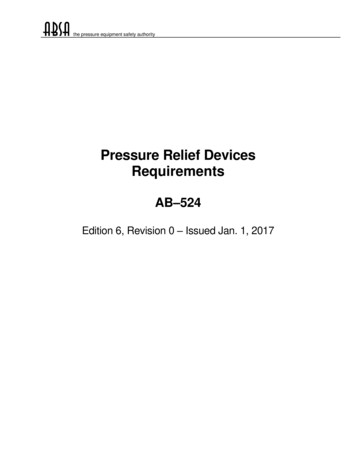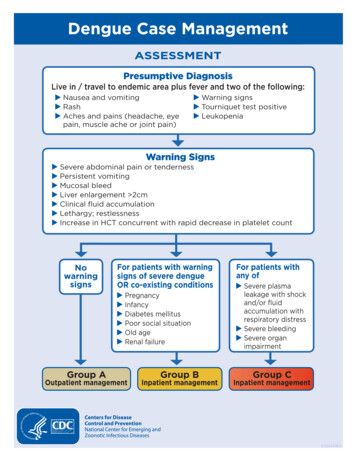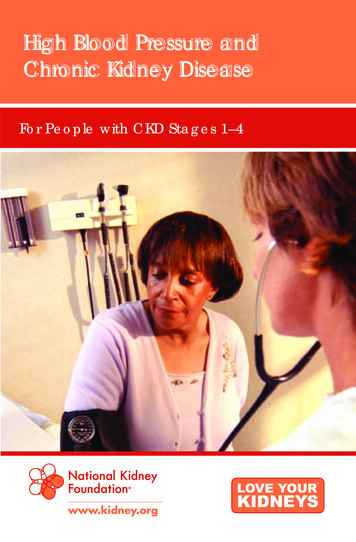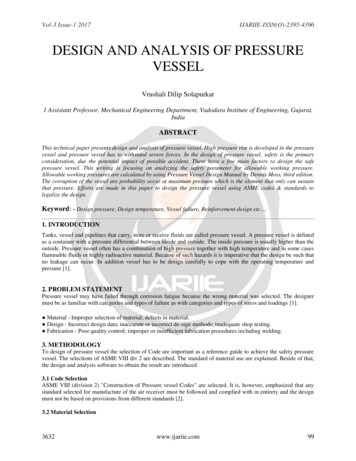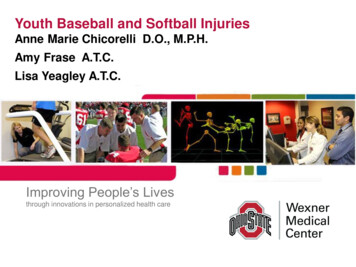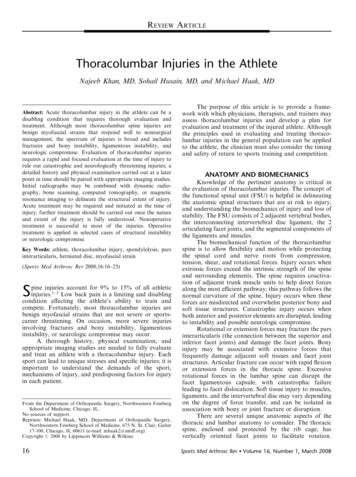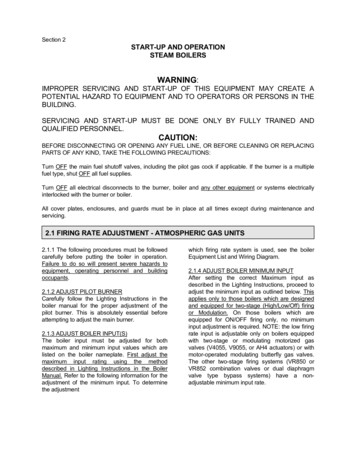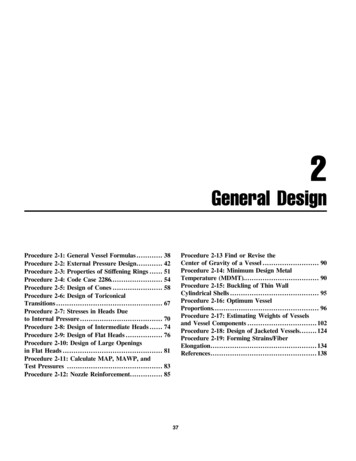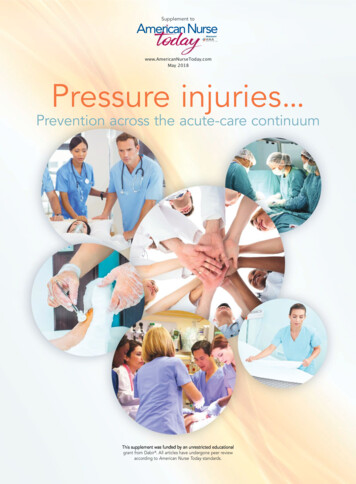
Transcription
Supplement towww.AmericanNurseToday.comMay 2018Pressure injuries.Prevention across the acute-care continuumgrant from Dabir . All articles have undergone peer reviewaccording to American Nurse Today standards.
Introduction to pressure injuries:Prevention across the acute-care continuumPressure injury prevention requires an effectiveand sustainable programBy Melissa A. Fitzpatrick, MSN, RN, FAANPressure injuries (PIs) have presented a significant risk to patients and a clinical challengeto nurses and other clinicians since beforenursing became a profession. The skin is thelargest organ of the body and although it doesn’tget the same attention as the heart, brain, liver,and lungs, it can be the most serious threat to apatient’s survival or at the very least, to his or hercomfort and well-being. How often does a criticalcare team work diligently to revive a patient incardiogenic shock only to have him succumb toan infected PI? What about the perioperative teamthat toils over the neurosurgical patient to successfully restore function only to have her succumbpostoperatively from the sequelae of a deep-tissueinjury?We know from the National Pressure UlcerAdvisory Panel that not all PIs are avoidable, butwe also know that most are when excellent assessment, physical care, multidisciplinary teamwork, and technology are used to ensure adequate perfusion.Never have our patients needed these caregiving elements more than today. With patient acuity,age, and comorbidities rising, risk for all so-called“never events” like PI has escalated as well. Thoserisk factors follow patients across the acute carecontinuum, so an effective PI-prevention programmust include many care environments—including perioperative units, interventional radiology,cardiac catheterization labs, dialysis units—thatweren’t historically part of the plan. For example, patients who are “boarding” in the ED on astretcher for hours or even days require the sameskin protection as those who’ve been admitted toan inpatient bed. And those in the OR who areanesthetized and unable to reposition themselvesare at risk for PIs. Decreases in perfusion are cumulative, and they’re perpetuated across care settings when adequate perfusion isn’t assured. Askin injury that begins in the ED can be exacerbated in the OR and then appear as a PI in thecritical-care unit. Patients need pressure redistribution and tissue off-loading in all care settings.AmericanNurseToday.comThis special report takes all ofthese patient, team, and environmental factors into account and describes best practices, tools, andsolutions for skin safety. I want tothank the thought leaders whoshared their wisdom in creating thisbody of knowledge. The authors describe the current state of PIs andtheir assessment and prevention aswell as strategies used to mitigaterisk across a variety of acute-caresettings. They also share best practices for multidisciplinary collaboration across settings to ensure that prevention practices are sustained aspatients transfer from one area to another. In casestudies, you’ll learn how clinical experts have explored a variety of approaches and solutions thatyou can put into practice tomorrow.You’ll also find discussions on technology solutions and strategies for making the businesscase to acquire the technology needed to supportyour PI-prevention initiatives.The many spokes on the PI prevention wheelmust be in full gear to create an effective andsustainable program. As patient needs and acuityescalate, clinical excellence and patient advocacywill be more important than ever. Industry experts can play an important role as your partnersin clinical quality and patient safety. At Dabir, ourmission is to be your partner as you create evidence-based practice environments and teams thatprevent PIs and enhance patient outcomes. Wehope that this special report will assist you andyour teams in these efforts and provide you thebest solutions and approaches to PI prevention. Melissa A. Fitzpatrick is vice president and chief clinical officer at Dabir,Inc., the healthcare division of Methode Electronics.Selected referencesBlack JM, Edsberg LE, Baharestani MM, et al; National PressureUlcer Advisory Panel. Pressure ulcers: Avoidable or unavoidable?Results of the National Pressure Ulcer Advisory Panel ConsensusConference. Ostomy Wound Manage. 2011;57(2);24-37.May 2018Pressure Injuries1
Supplement toPressure InjuriesCONTENTSwww.AmericanNurseToday.comMay 20181Introduction to pressure injuries:Prevention across the acute-carecontinuumBy Melissa A. FitzpatrickPressure injury prevention strategies, casestudies, and much more are part of thissupplement. The supplement is dividedinto three sections.Pressure injuries (PIs) across the acutecare continuumTake action to solve causes ofpressure injuriesBy Jan Powers and Corrine (Cori) AmesAll acute-care settings face challenges inpressure injury prevention, but solutionsare available.7The challenge of pressure injuriesThis infographic depicts alarming statisticsfor pressure injuries in acute care.Section 2:Acute-care environments8Best practices for pressure injuryBprevention in the EDpreBy Diane LongPressure injury prevention isPrefrequently overlooked in thefreED. Learn how to keep it aEpriority.pr2Pressure Injuriesprevent pressure injury inmedical-surgical patientsBy Joyce BlackThese three steps—determining risk level,reducing pressure, and improving pressuretolerance—will help you reduce med-surgpressure injuries.12 CASE STUDY: Preventing pressureSection 1:410 Take three steps forward toMay 2018injuries in medical-surgicalpatientsBy Catherine SpaderJill Cox, PhD, RN, APN-C, CWOCN/APN,describes how she overcomes competingpriorities to provide nurse educationabout PI prevention.14 Preventing pressure injuries incritically ill patientsBy Peggy KalowesEvidence-based PI-prevention care bundles ensure consistency focused on risk,surface selection, turning, incontinencemanagement, and nutrition.17 CASE STUDY: Critical care of theskinBy Catherine SpaderDebra Crawford, BA, ADN, RN, CWOCN,CFCN, describes how she and her teamprioritize pressure injury prevention in themidst of critical care challenges.19 Preventing pressure injuries in theoperating roomBy Rebecca J. McKenzie and CandaceRamierzPatients who present with PIs within 72hours after surgery acquired them intraoperatively. Learn how you can help stopPIs before they start.AmericanNurseToday.com
22 CASE STUDY: Making strides in ORpressure injury preventionBy Catherine SpaderKristen Oster, MS, RN, APRN, ACNS-BC,CNOR, CNS-CP, developed a successfulprogram that combines knowledge, devices, and good nursing care.24 CASE STUDY: Changing times andperioperative pressure injurypreventionBy Catherine SpaderPatricia Mullen Reilly, CRNA, BSN, is a staffnurse anesthetist who emphasizes the importance of a culture of prevention in the OR.26 Preventing PIs across the acutecare continuumNurses in all acute-care settings are instrumental in preventing pressure injuries. Reviewthese strategies and put them into action.Section 3:Clinical solutions for PI prevention27 Collaborative interdisciplinaryteams and pressure injurypreventionBy Angie Bergstrom, Peggy O’Harra,Wanda M. FosterPressure injury prevention starts with perioperative and critical-care staff workingtogether to provide consistent care.29 CASE STUDY: Collaboration improves31 Product evaluations: CollabCollaboratingwith value analysis committeesBy Armi Earlam, Lisa Woods, Sharon E.SpuhlerLearn how to work with value analysiscommittees to bring high-quality, costeffective PI prevention devices into youracute-care setting.33 Framing a strategy for eliminatingpressure injuriesBy Nancy M. ValentineLeadership is key to transforming hownurses and healthcare organizations address pressure injury prevention.35 Navigating the maze of supportsurfacesBy Deborah Sidor and Mary SieggreenNot all support surfaces are the same.Before choosing one for your patient,make sure you understand the options.38 How to navigate support surfaceoptionsUse this infographic toohhelpelp you deterdetermine the rightsupport surfacefor each patient.pressure injury preventionBy Catherine SpaderDebra L. Fawcett, PhD, RN, uses rootcause analysis and staff participation in research to raise awareness about pressureinjury prevention.AmericanNurseToday.comMay 2018Pressure Injuries3
PIs across the acute-care continuumTake action to solve causesof pressure injuriesAcute-care settings present challenges forPI prevention, but solutions existSection 1By Jan Powers, PhD, RN, CCNS, CCRN, NE-BC, FCCM, and Corinne (Cori) Ames BSN, RN, CMSRNNurses are on the frontlines of pressure injury (PI) prevention, assessment, and management. Understanding PI risks and causes and having a firm grasp on the tools and skillsrequired for accurate assessment help to ensuresuccessful patient outcomes. (See PI etiology.)In this article, we’ll discuss nursing considerations related to PIs within the acute-care setting,including methods to enhance patient care.Risk factorsWhile the most significant PI risk factor is reduced movement or immobility, several factorscan place patients at risk, including decreasedperfusion and oxygenation, increased skin moisture and temperature, friction and shear, decreased sensory perception, hemodynamic instability, vasoactive medications, intensive careunit (ICU) length of stay, surgery, and overallhealth status. Pressure from medical devices—such as catheters, and I.V. and endotrachealtubes—also can cause PIs. And patients with existing PIs are at increased risk for others.Nutritional deficiency and advanced age havebeen shown to increase the risk of PIs. Agingdecreases dermal thickness and sensory perception, which can lead to more rapid tissue injury4Pressure InjuriesMay 2018but leave patients less likely to respond to tissuecues to change position. Poor nutritional statusmay result in decreased protein, rendering tissuemore susceptible to the effects of pressure.Intensive nursing care decreases complications and improves patient outcomes. Studieshave suggested that PI development also canbe affected by the number of nurses and timespent at the bedside. A structured approachthat includes comprehensive risk assessment isrecommended to identify PI risk. Use a reliableand valid tool appropriate to the specific patient population, and implement interventionsspecific to the patient’s needs based on thescoring criteria used.Acute-care challenges and solutionsNurses in acute-care settings often juggle multiple needs for multiple patients, some with several comorbidities, which requires impeccable organizational skills. All acute-care settings shouldhave a comprehensive prevention program thatincludes risk assessment, skin care, pressure redistribution, friction and shear management, incontinence/moisture management, nutritional assessment and interventions, education (for bothclinical staff and patients), and communication.AmericanNurseToday.com
PI etiologyPressure injuries (PIs) occur when direct pressure causes tissue ischemia in the skin, muscle, and fascia. This typicallyoccurs over bony prominences, but also can occur in other locations. Direct pressure causes compression of small vesselsand prevents oxygen from being delivered at the capillary interface, resulting in edema that further compresses smallvessels and increases tissue ischemia and death. Pressure duration and intensity are directly related to tissue damage.Most PIs occur on the sacrum, coccyx, and heels.Pressure of boneagainst hard surfacePinching off ofblood vessselsFriction of skinagainst the surface(See Key strategies.) However, specific settings—ICU, emergency department (ED), and operatingroom (OR)—have their own unique challengesand solutions. Here’s an overview; you can learnmore by reading related articles in this specialreport.Emergency departmentPatients in the ED often present with life-threatening or serious health conditions that take priority over skin assessment. However, while patients are in the ED, they’re typically cared foron transport carts that may not have the sametypes of pressure-reduction mattresses as hospitalbeds. Some facilities have protocols to add additional pressure-reducing surfaces for high-riskpatients in the ED. Also, because many patientsmove out of the ED quickly, no protocol existsfor turning patients at least every 2 hours. Takenote of patients who stay longer than 2 hoursand reposition them as needed.Operating roomUnique challenges in the OR include operating tables and required patient positioning. OR tablesare rigid and can cause significant PIs if they’re notappropriately padded or if the patient isn’t properly positioned. Similarly, medical devices used durAmericanNurseToday.coming surgery should be padded and carefully positioned to prevent PIs. Because patients can’t berepositioned during surgery, assess for potentialpressure areas and patient risk, and request prevention accommodations before surgery begins.Intensive care unitPatients in the ICU must contend with multiplemedical devices that may cause PIs, as well asconditions and medications that may cause vasoconstriction and reduce blood flow to the skin.The resulting decrease in perfusion and oxygenation may make patients more susceptible to PIs.Patients in the ICU generally require multiplemedications for hemodynamic instability, whichmay make repositioning a challenge due to bloodpressure changes. You can still shift patients to relieve pressure, just use smaller adjustments andturns. In addition, patients in the ICU are at increased risk of malnutrition and require interdisciplinary coordination to implement early nutritionalsupport. They also may experience temperaturevariations—either hypothermia, which decreasesperfusion, or hyperthermia, which increases moisture. Maintain normothermia when possible.Nursing considerationsThe most important aspect of nursing care is diliMay 2018Pressure Injuries5
Key strategiesFollow these key strategies to prevent pressure injuries in acutecare settings. Use support surfaces that offer pressure relief/reduction andmanage the microclimate. Reposition patients to reduce the duration and intensity ofpressure over vulnerable areas. Avoid positioning the patienton bony prominences with existing nonblanchable erythema. Use transfer aids to avoid dragging the patient while repositioning and reduce friction and shear forces. Use positioning devices to offload sacral pressure (30-degreeside-lying position) and prevent pressure on bony prominences. Assess whether actual offloading has occurred byplacing your hand under the patient’s sacrum to determinewhether it’s off the bed. Teach chair-bound patients, who are able, to shift theirweight every 15 minutes. Use pressure-relieving surfaces under patients while they’re sitting. Maintain a clean environment and use containment and barrier products to protect the skin from stool, urine, and otherfluids. Clean skin promptly after incontinence. Manage skin microclimate by decreasing/absorbing moisture,containing moisture, and managing temperature (maintainnormothermia). Choose support surfaces that provide microclimate management. Assess nutrition and hydration. Consult dieticians as appropriate. Check all medical devices for potential pressure; removepressure or pad the device as necessary. Consult with certified wound care nurses to help determineprevention strategies. Use prophylactic dressings over bony prominences as indicated.gent assessment and implementation of prevention strategies. Assessments should be performedat admission, by each nurse on each shift, whenpatients are transferred, and at discharge. Manyorganizations have adopted two-person skin assessment at admission. The skin assessment scoreshould then direct you to the appropriate prevention strategies.Use protocols, guidelines, order sets, or careplans that outline appropriate nursing care measures based on risk assessment and preventionstrategies. The bundle approach is a comprehensive, collaborative solution for PI prevention orreduction. In two recent studies, PIs were decreased significantly after implementing a bundleof prevention strategies.Prophylactic dressings, such as a polyurethanefoam dressing on bony prominences, may helpprevent PIs in anatomical areas frequently subjected to friction and shear. These dressings alsocan be used to protect skin from medical devices. Choose prophylactic dressings designed toallow for regular skin assessments. For example,6Pressure InjuriesMay 2018they should have soft silicone borders that areeasy to lift for routine skin checks without creating tape burns or other injuries.Other research-based measures include standardized communication tools to enhance interdepartmental collaboration, and support surfaces—such as mattress overlays and specializedbed surfaces—that alter the microclimate by regulating the rate of moisture evaporation and heatdissipation.A centerpiece of carePIs can occur in any acute-care environment. Youand your colleagues should understand the factorsthat place patients at increased risk for PI and beknowledgeable about prevention strategies. A onesize-fits-all prevention option doesn’t exist, so thebest approach is comprehensive, collaborativebundling of multiple interventions individualizedto each patient. Make PI awareness and educationa centerpiece of your nursing care. The authors work at Parkview Health in Fort Wayne, Indiana. Jan Powersis the director of nursing research and professional practice. Corinne (Cori)Ames is nursing services manager 3—surgical and inpatient wound care.Selected referencesAnderson M, Finch Guthrie P, Kraft W, Reicks P, Skay C, BealAL. Universal pressure ulcer prevention bundle with WOC nursesupport. J Wound Ostomy Continence Nurs. 2015;42(3):217-25.Brindle CT, Wegelin JA. Prophylactic dressing application toreduce pressure ulcer formation in cardiac surgery patients. JWound Ostomy Continence Nurs. 2012;39(2):133-42.Bryant RA, Nix DP. Acute and Chronic Wounds: Current Management Concepts. 5th ed. St Louis, MO: Mosby, Inc; 2016.Cooper KL. Evidence-based prevention of pressure ulcers inthe intensive care unit. Crit Care Nurs. 2013;33(6):57-66.Joint Commission Resources, The Source, Joint CommissionCompliance Strategies. Under Pressure: Preventing perioperative pressure injuries 15(11):1-22. jcrinc.com/the-source/Molon JN, Estrella EP. Pressure ulcer incidence and risk factors among hospitalized orthopedic patients: Results of aprospective cohort study. Ostomy Wound Manage. 2011;57(10):64-9.National Pressure Ulcer Advisory Panel. Prevention and treatment of pressure ulcers: Clinical practice guideline. ers-clinical-practiceguideline/National Pressure Ulcer Advisory Panel. Pressure injury prevention points. 2016. ry-Prevention-Points-2016.pdfSwafford K, Culpepper R, Dunn C. Use of a comprehensive program to reduce the incidence of hospital-acquired pressure ulcers in an intensive care unit. Am J Crit Care. 2016;25(2):152-5.Yusuf S, Okuwa M, Shigeta Y, et al. Microclimate and development of pressure ulcers and superficial skin changes. IntWound J. 2015;12(1):40-6.AmericanNurseToday.com
The challenge of pressure injuriesStatistics related to pressure injuries (PIs) are alarming. About 1.2 million cases of hospital-acquired PIs occurred in 2015—36.3 per1,000 discharges (31.6% of total hospital-acquired conditions). Patients with PIs have longer lengths of stay (7 vs. 3 days), higher mortality (9.1%vs. 1.8%), and higher costs (median total cost of 36,500 vs. 17,200), compared tothose without PIs. More than 17,000 PI-related lawsuits (average cost 250,000) are filed each year.PIs are the second most common claim after wrongful death; more common thanfalls or emotional distress. As of 2008, the Centers for Medicare and Medicaid Services doesn’t pay forhospital-acquired PIs. Up to60,000 Americans die each year as a direct result of a enges Carts with mattresses that providelittle support OR tables provideinsufficient support Long wait times fora bed Lack of PI prevention awareness Attitude of insufficient time for prevention because“We’re busy savingtheir lives.” Inability to assesssome areas duringsurgery Failure to understand that a PI discovered after surgery originatedduring the procedure, so feedbacknot provided toOR ges Multiple medicaldevices can causePIs Lack of mobility Hemodynamic instability that reduces blood flowto the skin The variety ofstakeholders leadsto challenges increating comprehensive preventionprograms Lack of commonassessment tools Difficult positioningrelated to equipmentNote: Older and younger patients and those with nutritional problems, as well as clinicians’ insufficient knowledgeof the importance of support surfaces (and how to choose one), create challenges in all acute-care areas.Sources: 2016 National Healthcare Quality and Disparities Report chartbook on patient safety. Rockville, MD: Agency for Healthcare Research and Quality;July 2017. AHRQ Pub. No. 17-0037-EF. bit.ly/2Iv75n1; Bauer K, Rock K, Nazzal M, Jones O, Qu W. Pressure ulcers in the United States’ inpatient populationfrom 2008 to 2012: Results of a retrospective nationwide study. Ostomy Wound Manage. 2016;62(11):30-8; Agency for Healthcare Research and Quality. Preventing pressure ulcers in hospitals: Are we ready for this change? 2014. bit.ly/2H9MbKEAmericanNurseToday.comMay 2018Pressure Injuries7
Acute-care environmentsBest practices for pressureinjury prevention in the EDDon’t let urgent and emergent needsovershadow PI prevention.Section 2By Diane Long PhD, RN, SCRNInjuries were once thought to be unavoidableoccurrences or accidents, but the EmergencyNurses Association (ENA) states that “injuriesfollow a predictable pattern, thus making thempreventable.” The National Pressure Ulcer Advisory Panel describes a pressure injury (PI) as a“localized injury to the skin and/or underlyingtissue usually over a bony prominence, as a result of pressure or pressure in combination withor emergent priorities can leave PI preventionlost in the shuffle.A 2017 meta-analysis found that PI incidencein ED patients ranged from 0.38% to 19.1%, andthat the pooled incidence was 6.3%. The authorsnoted that even during a short stay in the ED, PIis a “common occurrence,” especially stage 1 injuries that can occur within just a few hours ofarrival. Changing ED patient demographics havecontributed to these statistics; ED stays havelengthened, and aging Baby Boomers are arriving sicker and with multiple comorbidities.Early recognition, prevention interventionsshear.” This meets the ENA’s assertion of a discernible pattern, which means PIs are preventable. Preventing new PIs or exacerbation of current injuries is an ongoing standard in emergencydepartment (ED) nursing, but competing urgent8Pressure InjuriesMay 2018Recognizing PI risk factors early and institutingappropriate preventive interventions should bebest practice among ED nurses. Recognition canbegin before the patient arrives at the hospital.In the emergency medical service (EMS) setting,PI has only recently been directly addressed andonly in conjunction with injuries caused by cervical spine collars and long backboards. EMSculture is still struggling with the idea that longbackboards aren’t needed in most instancesand should more properly be called “extrication boards.” The current focus of EMS personnel is the immediate emergent needs of thepatient, which hasn’t embraced consideration ofpatient outcomes beyond that. Just as our EDculture will struggle to adapt to the new visionof PIs, EMS must work to incorporate PI considerations into their field of patient care.Considering an ED patient’s chief complaintand comorbidities is an essential first step in theearly identification of PI risk. ED staff shouldwatch for these risk factors: age (extremes of age—young and old) limited mobility or the inability to reposition loss of sensation malnutrition and dehydration moisture (incontinence) previous PI (skin over a healed PI may still beweaker than normal)AmericanNurseToday.com
Structured risk assessment current PI poor general health altered level of consciousness.Evidence-based PI practices include risk assessment and preventive care interventions thatimprove patient outcomes and are cost effectivefor the organization.Risk assessmentStructured risk assessment should begin as soonas possible after the patient arrives in the ED andthen be repeated based on patient acuity (at leastonce per shift and when the patient’s conditionchanges or deteriorates) and immediately beforedischarge. A validated risk assessment tool appropriate to the patient population, such as theBraden Scale for Predicting Pressure Sore Risk,can be useful, but it shouldn’t be a substitute foryour nursing judgment. (See Structured risk assessment.)PreventionPreventive care interventions focus on skin care,patient positioning, nutrition, and education.Skin careKeep patients’ skin clean and dry. For those withincontinence, implement a continence plan usinginternal or external urine collection devices. However, avoid adult briefs when possible; they’re asource of moisture retention and concealment.Skin damage from incontinence predisposes patients to injury. Consider prophylactic dressingson bony prominences, and don’t position patientson areas of erythema.ED stretchers offer little pressure support, somove patients to an appropriate high-specification foam surface. For extended stays, move patients from an ED stretcher to a patient bed assoon as possible. A level A (high) ENA recommendation states that within 2 hours after a baseline skin assessment, a pressure reduction surfaceshould be used for patients who aren’t mobile.Fagan notes that mattress overlays are the leastexpensive and most readily available option forPI prevention in the ED.Patient positioningReposition patients frequently (at least every2 hours; every 30 minutes if the patient is immobile). When the patient is side lying, turnhim or her to 30 degrees; avoid 90-degree positions. Keep the head of the bed at less than30 degrees, if possible, to prevent sacral shear.When transferring patients, use shear-decreasAmericanNurseToday.comTo help prevent pressure injuries (PIs) in the emergency department, structured risk assessments should be conducted at leastonce per shift. In addition to performing a full-body skin assessment (which also can be done during bathing, toileting, andrepositioning), you’ll want to assess patient sensation, mobility/activity, and nutrition.Full-body skin assessmentDuring the full-body skin assessment, check: temperature, color, moisture edema, pain, and areas of tissue inconsistency healed and current PIs (these patients are automaticallydeemed high risk) areas around medical devices (such as nasal cannulas, endotracheal tube securement devices, and other lines anddrains) for potential PIs.Sensation assessmentDiminished or absent sensation increases PI risk because thepatient can’t sense pain as an indicator to change positions.Risk factors include: diabetes neurologic disorders and paralysis peripheral vascular disease; diminished sensation due to decreased blood flow.Mobility/activity assessmentBedfast and chairbound patients are at high risk for PI. Assesswhether the patient can: turn in bed (they should turn at least every 2 hours) stand and ambulate (with or without assistance).Nutrition assessmentConsider the following questions: Are height and weight proportionate? Can patients feed themselves? Are patients consuming adequate calories?ing devices and size-appropriate equipment to facilitate ease of turning.NutritionRemember to provide meals or snacks for patients who are waiting for a bed. Help patientswith their meals and monitor their calorie intake.EducationTeach patients about their personal PI risk factorsto encourage adherence to self-care plans. Sharethis information with family members and caregivers so they can help implement risk-reductionrecommendations. For example, patients withdiabetes are at risk for dehydration and loss of(continued on page 39)May 2018Pressure Injuries9
Take three steps forwardto prevent pressure injury inmedical-surgical patientsNursing care is key to pressure injury prevention.By Joyce Black PhD, RN, FAANPressure injuries (PIs) are a serious complication of immobility, and they’re a nursingquality standard. Insurers no longer reimburse for PIs that occur after hospital admission,and in some states, a full-thickness PI that develops during a hospital stay is reportable to theboard of health.The mission is clear—organizations must prevent PIs. If a PI occurs, early identification is keyto prompt treatment. As the healthcare professionals closest to the patient, nurses are criticalto achieving this mission. This article focuses onpatients on medical-surgical units.and results in a deep-tissue PI, which presents asa persistent, nonblanchable, deep red, maroon,or purple discoloration.Another situation in which injury can occurquickly is pressure from a medical device—aproblem that’s becoming more common as a result of the forms of plastic used in these devices.For example, placing a noninvasive pressuremask over the poorly padded tissue on the bridgeof the nose can easily lead to damage.In other cases, patients may be on a foam oralternating air support surface, so pressure isn’t ashigh against the soft tissue. But these patients alsocan develop PIs over time because of prolongedtissue ischemia. According to the National PressureUlcer Advisory Panel (NPUAP), a stage 1 PI hasintact skin with a localized area of nonblanchable erythema, but you won’t initially see
vices, and good nursing care. 24CASE STUDY: Changing times and perioperative pressure injury prevention By Catherine Spader Patricia Mullen Reilly, CRNA, BSN, is a staff nurse anesthetist who emphasizes the impor-tance of a culture of prevention in the OR. 26Preventing PIs across the acute-care continuum Nurses in all acute-care settings are .
